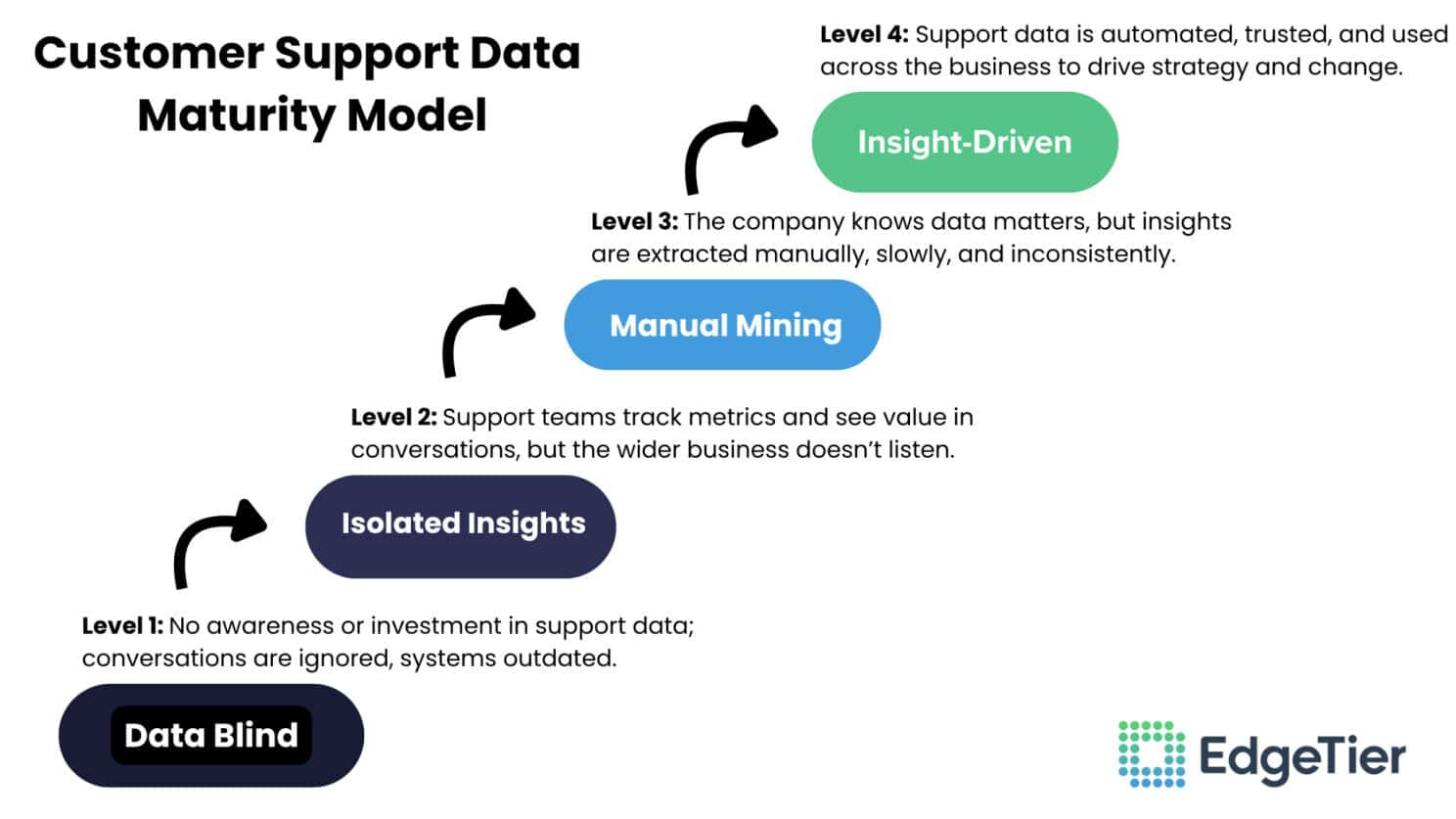Voice of the Customer Programs Explained: Challenges, Insights, and How to Get It Right
This article originally appeared on Edge Signals – Bart Lehane’s LinkedIn newsletter on customer experience, analytics, and AI. Follow for
This article originally appeared on Edge Signals – Bart Lehane’s LinkedIn newsletter on customer experience, analytics, and AI. Follow for future insights like this!Support data maturity defines how effectively a company listens to and acts on customer feedback hidden within its support conversations. Businesses that evolve from manual reporting to automated insight see dramatic improvements…

| This article originally appeared on Edge Signals – Bart Lehane’s LinkedIn newsletter on customer experience, analytics, and AI. Follow for future insights like this! Support data maturity defines how effectively a company listens to and acts on customer feedback hidden within its support conversations. Businesses that evolve from manual reporting to automated insight see dramatic improvements in customer experience, retention, and operational efficiency. This article explores the stages of support data maturity and why advancing through them is essential for turning customer conversations into business intelligence. Here’s what you’ll learn: ✔ The four levels of support data maturity – from reactive to insight-driven. ✔ Why customer support data is your most underused source of customer truth. ✔ How automation and mindset shifts unlock faster, more impactful decision-making. ✔ Practical ways to assess where your organisation sits today. |
When we talk to customer support leaders, one pattern stands out: while many want to become data-driven, few truly know where they are on that journey.
Your ability to turn support conversations into actionable insight directly affects how customers experience your brand – and whether they stick around.
Yet across industries, teams still sit at wildly different levels of support data maturity. Some are just starting to count tickets; others are using advanced analytics to guide business strategy.
Customer experience is now a primary competitive battleground. With products and pricing becoming increasingly commoditised, companies can only win on experience or efficiency.
But customer expectations are higher than ever. People expect your business to remember them – across every channel. They expect your teams to know what they’ve said before, and they expect that when they raise a problem, you’ll fix it.
The truth? Your customers already tell you what’s broken every single day – in their support conversations. The challenge isn’t collecting that feedback; it’s listening to it and acting on it.
At EdgeTier, we use a four-level model to describe how organisations evolve from reactive to insight-driven.

Support activity is tracked manually – if at all. Reporting might live in spreadsheets or scraps of paper. Analytics is minimal, and investment in modern tools is rare. Teams at this level often don’t realise what they’re missing.
Support teams begin tracking performance metrics and hear recurring customer pain points, but the rest of the organisation doesn’t engage. Product, marketing, and leadership teams overlook support as a data source. To move forward, support leaders must proactively share insights and prove their value.
This is where many modern businesses sit. Data is collected, and leaders are asking for insight – but processes are still manual. Reports pile up, feedback loops break, and decisions rarely change. Automation becomes key here: when conversation data is structured and reliable, insight finally scales.
At this level, customer support data fuels real business change. Insights flow automatically into product roadmaps, marketing strategies, and policy decisions. Support teams gain a seat at the decision-making table. One EdgeTier customer, Abercrombie & Fitch, described the impact best:
“EdgeTier gave me a seat at the decision-making table.”
This is the point where support stops being a cost centre – and becomes a competitive advantage.
Technology and processes exist to reach Level 4. The obstacle is mindset. Too often, leadership still views support as an unavoidable cost, not a growth driver. Remaining stuck in reactive mode leads to higher churn, higher costs, and weaker customer loyalty. In short: staying at Level 2 slowly erodes the business.
Take a moment to assess:
Your customers are already showing you what’s broken – in every interaction. The question is whether you’re ready to listen.
🔗 Read the full article on Bart Lehane’s LinkedIn post for examples, stories, and community discussion.
Bart Lehane is the Co-founder & CCO at EdgeTier and a PhD engineer who’s spent 20+ years building and delivering advanced technology. His background spans applied research, software development, and product management. His interests lie at the intersection of CX, AI, and tech.
This article originally appeared on Edge Signals – Bart Lehane’s LinkedIn newsletter on customer experience, analytics, and AI. Follow for
Black Friday isn’t just a sales event – it’s a stress test for your contact centre’s people, systems, and leadership.
Generative AI chatbots are transforming customer service – but also creating a new kind of risk. When AI assistants hallucinate,
"I specifically liked the flexibility. I liked the can-do attitude. I always felt supported. There hasn’t been any single point in our journey where EdgeTier has said no."
"We’re a big business, so getting the right people to agree and fix something hasn’t always been easy. Now we’ve got one version of the truth—it’s much easier to align and act"
"EdgeTier is no ordinary software product... It has completely changed how we work at CarTrawler."



Let us help your company go from reactive to proactive customer support.
Unlock AI Insights